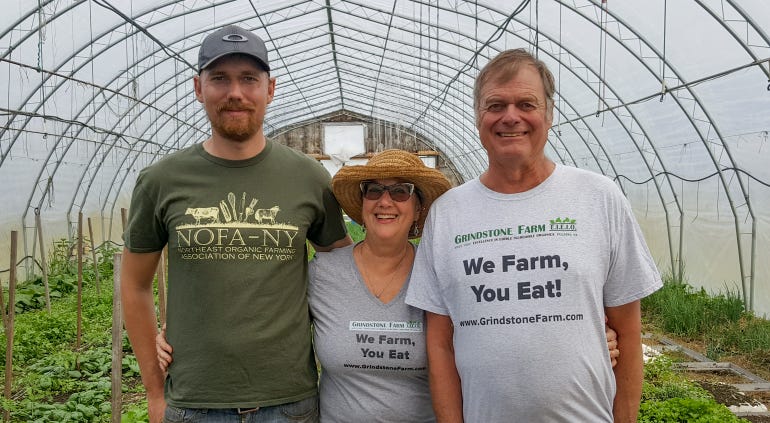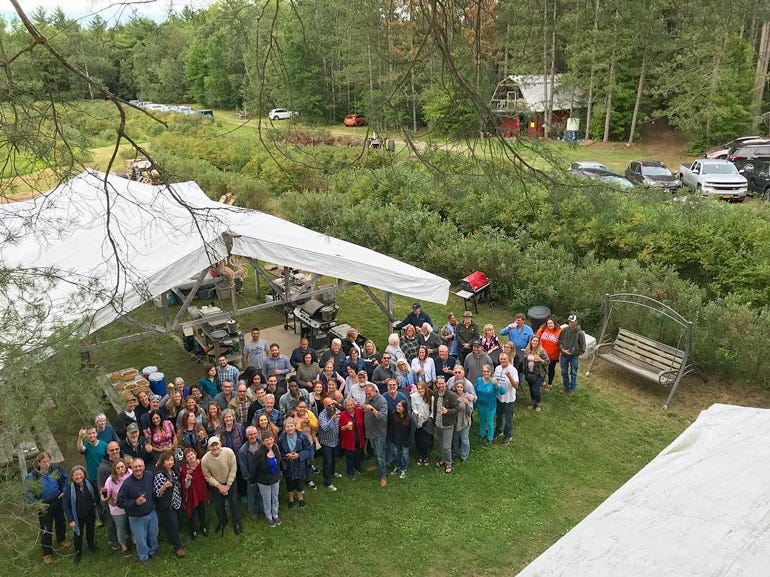May 30, 2019

By Deborah Jeanne Sergeant
Variety is the spice of life. For some farmers, it's the key to viability.
Dick de Graff, owner of Grindstone Farm in Pulaski, N.Y., has always been willing to alter his operation to meet consumer demand as well as farm and economic challenges.
In 1981, de Graff purchased 230 acres and began growing fruits and vegetables. He still grows about 40 acres of produce but has added so much more.
By 1988 he had transitioned the farm to organic and was certified by the Northeast Organic Farming Association of New York (NOFA-NY). The rise in consumer demand for organics, along with de Graff's concerns about using pesticides, prompted the change.
Going small, adding animals
As many of his fields are small, de Graff decided that his farm fit the small-scale model. He added animals to make more money and to provide more balance as an organic farm.
His pastured beef, pigs and chickens provide year-round income and keep the fields fertile. The pigs also consume produce he can't sell through his community supported agriculture (CSA) program or at the farmers markets he sells to.
De Graff supplements his animals’ diet with non-GMO feed, which he purchases from a local feed company in Lyons. The animals aren't certified organic, but they are grown using “natural practices.”
De Graff purchases chicks and raises them all summer and fall in portable chicken yards so they can eat a varied diet and can reduce the bug population on the farm. While he processes his own birds, pigs are sent away to be slaughtered.
The pigs join the farm as weanlings.
"We're certified organic, so it's important to have that animal component," he says. "I think diversity helps, but it adds to management and labor nightmares. If you're a one- to two-person operation, the more diverse you are, the more work you end up doing."
But he likes the diversity of the farm because if one crop or animal loses profitability, he can rely on something else.
Meeting demand
About 40% to 50% of what he raises gets sold through his CSA. Another 30% to 40% ships wholesale to a food co-op in New York City. The remaining he sells at farmers markets in Watertown, Oswego and Pulaski, along with a small amount used for on-farm events.
De Graff’s CSA grew to the point that he needed to add some items from nearby farms to ensure he could meet customer demand. He views his CSA boxes as competitive with services such as Blue Apron, which home-deliver prepackaged ingredients with recipes.
"They charge a lot of money. There's a lot of packaging and shipping involved,” he says. “We've always included recipes and a little newsletter. We don't get into fancy packaging. They're printed on paper, not something fancy, and aren't designed by a well-known chef."
He also doesn't include disposable freezer packs.
De Graff also sells blueberries wholesale to a craft beverage producer, Anything But Beer, in Syracuse.
He also sells root crop washing equipment during the winter months, utilizing his background in manufacturing.
Connecting with customers
Like many small-scale farmers, de Graff jumped onboard with social media. That step connected him with a chef last fall who wanted to partner with him to host a farm-to-table chef challenge in the Syracuse area. De Graff delivered a few boxes of produce and the chef had two hours to prepare a three- to five-course meal for 30 paired with local craft beverages.
"We talked about it and started working with him to come up with recipes, thoughts and ideas," de Graff says. "He did some of it at his restaurant, brought it and finished it here at the farm."
About 80 people showed up, but de Graff considers it successful.
"We can't say we made a ton of money, but it was good to meet some customers," he says. "We hope to make a little more money next time."
Live music, tents and a bonfire helped ramp up the ambiance. He hopes to offer similar on-farm events twice a year.
"We're trying to concentrate on doing a good job with the products we're growing and looking at delivery options with the farm support where we're serving 'X' number customers," he says. "It's easier to deal with wholesale clients who want a whole pallet, not half a box here and there."
In addition to his wife, Victoria, and son, Lucas, de Graff has four employees. He likes hiring locals to work on the farm during summer.
"We depend upon our capable staff, some of whom have been with us for several years," Victoria says. "We always bring new people on each year, and then when our biggest crop, blueberries, comes on, we hire a lot of day labor to harvest for us.”
 FAMILY FARMERS: Lucas, Victoria and Dick de Graff have changed their farm business to not only face economic challenges, but also to meet consumer demand.
FAMILY FARMERS: Lucas, Victoria and Dick de Graff have changed their farm business to not only face economic challenges, but also to meet consumer demand.

She retired in 2011 and told her husband that she didn't want to work on the farm. However, "he snuck some responsibilities in on me," she says.
She manages the farm's AirBnb cabin, helps with weekly deliveries when available and manages the farm's social media presence.
Lucas oversees the farm's newest enterprise: He collects used fryer fat from restaurants and converts it to biodiesel to heat greenhouses and run tractors and mowers.
He’s also started growing grains and cutting hay.
Future food hub
Dick is involved with Farm Bureau, NOFA-NY, Cornell Cooperative Extension and the local chamber of commerce. Through these connections he has generated more ideas for future ventures.
One of those is the creation of a food hub in Oswego County. He sits on a board that is soliciting farmers in Oswego, Lewis, Jefferson and St. Lawrence counties to join the food hub.
He envisions the hub one day including processed foods, but for now he is focused on produce. De Graff views it as a great way for small-sized farms to get more produce to market. But diversifying isn’t a simple thing.
 WELCOMING GUESTS: Hosting on-farm events is yet another way Grindstone Farm connects with the public and makes money.
WELCOMING GUESTS: Hosting on-farm events is yet another way Grindstone Farm connects with the public and makes money.

"Have a business plan with achievable milestones that have alternative conditions or terms if objectives are not met within the specified time period,” he says. “Farming is not just a job. Farming is a way of life and often it is hard to separate the two because they are interwoven.
"Without predefined business goals and consequences, the passion a farmer has for what he or she does often clouds the reality of business viability.�”
Sergeant writes from central New York.
You May Also Like




